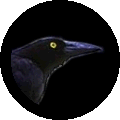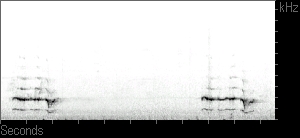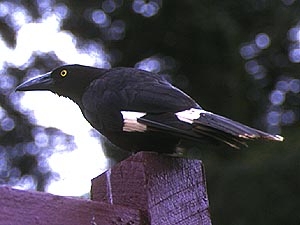 Pied Currawong
Pied Currawong
Strepera graculina
 Figure 1. Spectrogram of the
Pied Currawong song.
Figure 1. Spectrogram of the
Pied Currawong song. (The first two songs from the sound file are depicted.)

Image from Stefan Tewinkel's Bavarian Birds.
Pied Currawong - Strepera graculina
Pied currawongs have an eerie warbling voice. The songs of this large bird are rich in harmonics and often feature glottal, throaty sounds. Pizzey and Knight describe pied currawong songs as sounding like ‘currar-awok-awok-currar’ and ‘jabawok! jabawok!’ although their song also recalls their name ‘curra-wong’. Their voice travels very far through open forest, and their long distance communication seems to be facilitated by their habit of singing from atop tall trees. Songs are often given in long bouts at a rate of approximately one song every 4.5 seconds. On several occasions I observed lone currawongs alight on an exposed song post and give a long song bout until other currawongs began singing in the distance. The lone singer would change its song slightly, but continue to sing while flying off towards the other individuals.
Pied currawongs are not popular among bird-watchers because they are voracious predators on the nests of other birds, and have been accused of contributing to the decline of native Australian bush birds. However, others feel that pied currawongs are generalist predators which prey heavily on the nests of common introduced birds and abundant resident birds, but not as heavily as expect on the nests of rare native birds.
Habitat.
Although pied currawongs are commonly heard singing in treetops in open forests, such as the eucalypt forest of northeastern Australia, they will also visit suburbs and park lands and forage on the ground in small groups.
Range.
Pied currawongs are found along the entire east coast of Australia, from the tip of Cape York all the way to Melbourne.
Further Reading.
G. Pizzey & F. Knight. 1999. Field guide to the birds of Australia. Harper Collins, Sydney.
K. L. Bayly & D. T. Blumstein. 2001. Pied currawongs and the decline of native birds. Emu. 101:199-204.
No recordings, photographs, or other information may be used without written permission (email me at dmennill AT uwindsor DOT ca).